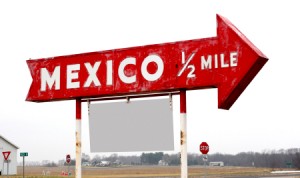- kristalalley@gmail.com
If your company has been sitting on the sidelines waiting for some semblance of certainty to return to the U.S. economy it could be a long wait. Instead of yet another ‘wait and see’ year, now might be the time to grasp new opportunities and expand into overseas markets. World trade is expected to grow approximately 5% in 2013 and then continue to pick up to about 6-7% a year in 2014-16.
 Growing annually at well over 3%, Mexico’s economy is in the trillion dollar class. It’s the United States’ 3rd largest trading partner and with 11 FTAs covering 44 markets, including with the US and Canada via the North American Free Trade Agreement (NAFTA), it has loudly embraced the free trade trend.
Growing annually at well over 3%, Mexico’s economy is in the trillion dollar class. It’s the United States’ 3rd largest trading partner and with 11 FTAs covering 44 markets, including with the US and Canada via the North American Free Trade Agreement (NAFTA), it has loudly embraced the free trade trend.
That said, big decisions should not be taken blindly. Below are 5 things to know before expanding south of the border.
#1: NAFTA is not a Customs Union
While all tariffs and quotas have been eliminated on U.S. exports to Mexico and Canada under NAFTA, NAFTA is not a customs union. What’s the difference? A free trade area is a group of states which have eliminated most or all tariffs and quotas on their trade. A customs union, like the European Union, involves internal free trade (no border checks), but has a common external tariff. Its members surrender their separate commercial policies and give up the right to sign individual trade agreements. Instead, this must be done by the bloc as a whole.
In practice, this means that when doing business with Mexico, the goods are stopped at the border, inspected, documentation and required certificates are checked and verified. The process can be complicated and exporters should plan to hire an experienced freight forwarder and customs broker. Also, it’s still necessary to check the tariff treatment of each product and understand that “NAFTA treatment” applies only to the U.S. content in a given product, not to any product shipping from the United States.
#2: Think through Payment Options Carefully
Exporters often lose sales because of the payment terms they demand of Mexican buyers. In Mexico, interest rates are high and there is a lack of financial options available for small- and medium-sized Mexican buyers. Because financing is an important factor when these companies choose a supplier, firms that offer the most flexible credit terms often win the sale. While securing payment is important, demanding a confirmed Letter of Credit or Cash in Advance may be a deal breaker. Given this reality, exporters should consider the wide variety of payment terms available to them in order to be as competitive as possible.
#3: Compare Wage Rates – Mexico vs. China
Investing in Mexico is also an option. While low wages have never been the sole determining factor when companies decide where to site manufacturing facilities, combine wage factors with location and Mexico’s star starts shining even brighter. The cost for an average factory worker in a Chinese industrial zone is more or less equal to a Mexican working in a maquiladora near the U.S. border with the average wage of a manufacturing employee in China between $1.65 and $1.85 per hour and Mexico ranging from $1.85 to $2.25. Mexican workers typically produce more per hour than Chinese workers and work 4 hours more per work week. Mexico also recognizes the need to improve its skills base and now graduates 55,000 engineers a year.
#4: Access other Markets via Mexico’s many FTAs
Mexico has more trade agreements in place than any other country in the world. It’s possible to take advantage of Mexico’s FTAs to gain preferential access to other markets. Its FTAs give manufacturers access to 66% of the world’s GDP from a single place. Some U.S. companies are already taking advantage of this by doing their R&D and design in the United States and their fabrication in Mexico in order to sell their product to Brazil. Of course, certain rules apply. In order for your product to qualify it must meet ‘preferential rules of origin’ standards. In other words, the finished product must have a minimum percentage of local/regional content, which means, in most cases, having a local manufacturing or value-added partner.
#5: Security is Important – but not a Make or Break Factor
Despite headlines to the contrary, Mexico can be described as a predominantly peaceful country with pockets of extreme violence. For those exporting to Mexico, security is largely a non-issue. For companies with FDI, or considering FDI, it is important for companies to be aware of these pockets of violence and manage business security risks (these include cargo theft, extortion, kidnap for ransom, etc) through developing and implementing effective security practices and policies.